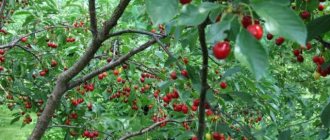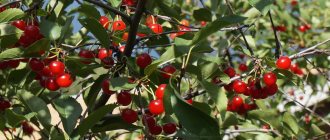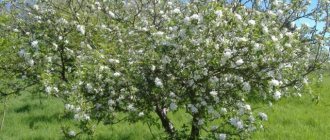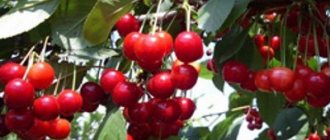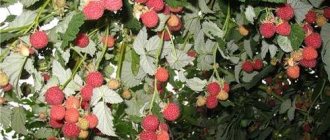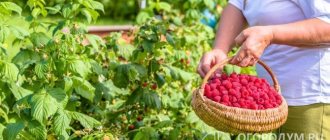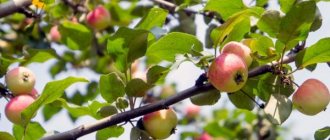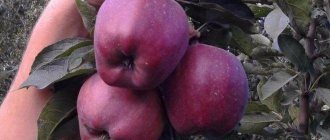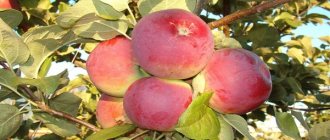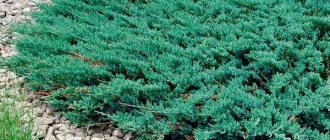Self-fertile cherry Volochaevka - what kind of variety is it
Volochaevskaya cherry is a common garden crop that is characterized by high productivity.
Main characteristics of culture, advantages and disadvantages
According to the description of the variety, Volochaevka cherry is considered a medium-sized crop. The height of trees of this variety reaches 3-3.5 m. They are characterized by a beautiful rounded crown and large ovoid leaves.
The tree is distinguished by straight brown shoots. Fruiting occurs on last year's branches and bouquet shoots. Young branches include only vegetative buds.
According to reviews, the berries of this cherry are quite large in size. However, the description of the Volochaevskaya cherry says that the average weight of 1 fruit is approximately 3-4 g. Experienced gardeners believe that the size and taste of the fruit are influenced by the climate of the area in which the plant is grown and the composition of the soil.
Cherries of this variety are characterized by a bright red hue. The juice also has the same color. This means that the culture can be categorized as griots or morels.
The fruits contain:
- 15.6% dry matter,
- 10% sugar,
- 1.4% acids.
The berries are distinguished by dense and juicy pulp. At the same time, there is a small bone inside that can be easily separated. According to the tasting scale, the taste of the fruit can be rated at 4.7 points.
History of selection
In 1997, a new cherry variety called Volochaevka was registered in the state register of breeding achievements of the Russian Federation. The selection work was carried out by a group of scientist-breeders under the leadership of A.I. Evstratov. Vladimirskaya and Lyubskaya cherries acted as “parent” varieties.
Did you know? When Prince Yuri Dolgoruky founded Moscow, cherry was the only fruit tree that grew in these parts at that time.
It is noteworthy that both varieties have been known to gardeners since the 18th century. The resulting variety is grown everywhere, although it is recommended for the central region of the Russian Federation.
Cherry variety ripening period, yield indicators
The culture belongs to early-fruiting varieties. The trees are growing quite strongly. In this case, fruiting begins at 4-5 years of age - at this stage their height is about 3 m.
If you provide the plant with favorable conditions, the yield parameters reach 10 kg. The maximum number of fruits that can be collected is 12-15 kg.
Note! The average lifespan of a tree reaches 15 years. In the south, this figure may be more than 20 years.
The flowering of the crop begins in May. This deadline may be slightly shifted - to the beginning or end of the month. The specific period depends on the growing region.
Characteristics of the variety
Volochaevka cherry is winter-hardy , but its frost resistance has limits: at temperatures below -30, the buds suffer and this has a bad effect on the harvest. Shokoladnitsa, Chernokorka, Shubinka, Shchedraya are also winter-hardy.
It begins to bear fruit in the 4th year and yields about 12 kg , which is considered a high yield. It bears fruit annually at the end of July. Malinovka, Black Large, and Nadezhda also demonstrate excellent productivity.
This suggests that the variety is “late” , and earlier ones, for example Annushka, ripen in June or early July. Other advantages include good resistance to moniliosis and coccomycosis, although it is considered average.
The variety is self-fertile , so it does not require cross-pollination and the yield does not depend on pollinating insects, proximity to other trees and the vagaries of the weather.
Rovesnitsa, Mayak and Molodezhnaya are also self-fertile.
Growing technique, planting and subsequent care
An excellent option for planting a plant is considered to be a southern or south-eastern slope, which receives maximum sunlight. It is also permissible to plant Volochaevka in partial shade. However, this will negatively affect the taste of the fruit.
Optimal soil types
When choosing a site for planting, it is worth considering the location of groundwater. They must be at a depth of at least 1.5 m. In extreme cases, the plant can be placed on an artificial embankment. The soil must be fertile and have good drainage.
Important! The hole for planting the plant should be made in advance. In this case, the soil must be mixed with ash, sand, humus, and mineral fertilizers.
The plant must be planted in fertile soil
Reproduction methods
Most often, the plant is propagated by its own root cuttings. They can be harvested from any tree that bears fruit. In addition, Volochaevka cherries can be propagated by grafting.
Pruning and crown formation
Cherry trees must be pruned annually to free the trunk from excess weight. It is important to get rid of dry branches. You also need to remove shoots that interfere with the normal growth of the crop.
Most often, pruning is carried out in the spring. However, removing broken branches can also be done in the fall.
The tree needs to be pruned promptly
Compliance with growing rules
Despite the fact that the Volochaevka variety is unpretentious, it is worth paying special attention to a number of mandatory rules. It all starts with choosing the right landing site. The optimal time is April. The holes are made at a distance of 3 m from each other. Their diameter and depth are 60 cm. Compliance with the specified aspect ratio allows you to form the root system in a straightened position.
Before planting, the following substances are added to the soil:
- humus;
- potassium chloride;
- ash;
- superphosphate.
At the next stage, a peg is driven into the center of the hole, which is subsequently used to tie the seedling. As soon as the nutrient mixture is poured, the surface is carefully leveled and compacted. You need to make sure that the root collar protrudes slightly above the soil surface.
Watering and fertilizing
Recommended volume – 50 liters at a time. If the gardener uses dry mineral fertilizers, then the indicated volume increases by 1/3. Do the same during dry weather. The tree must be watered after flowering, during the fruiting period and in early autumn. One of the advantages of the Volochaevka variety is the minimum level of fertilizers that should be applied. You should not overfeed cherries, otherwise there will be more problems than benefits. When choosing fertilizers and determining the intensity of their application, it is recommended to rely on the following indicators:
in the second year, urea is added;
- in the third year, diluted nitrogen fertilizer is applied in the spring;
- Year IV is the time to add urea in the spring-summer season;
- in the fourth year, double superphosphate and potassium sulfate are added in the fall;
- V-VI year – ammophoska is added;
- Year VII – urea is added in the spring.
Subsequently, the gardener adds only minerals every 12 months. It is also worth remembering about liming. It is carried out every 5 years. Dolomite, limestone and chalk - a list of everything necessary for this procedure.
Regular loosening of the soil and pruning
It is done throughout the growing season. The optimal amount is 3 times. For the second procedure, a lower intensity is required - once a year. Dried branches and those that interfere with proper growth must be removed. Pruning is carried out only in spring.
Blue manicure - current ideas, beautiful combinations and fashion trends. 105 photos and videos of examples of using blue in manicure
Resistance to adverse factors, diseases and pests
The plant has high resistance to coccomycosis. This disease can develop exclusively in rainy weather. However, after proper treatment, it completely disappears.
The plant has average resistance to other diseases and parasites. To prevent problems from occurring, you need to engage in prevention.
Cherry of this variety is highly frost-resistant. It can be grown not only in the Moscow region, but also in regions with a more severe climate. The plant is often planted in Chelyabinsk.
Step-by-step planting technology
Autumn planting of Volochaevka cherries is practiced only in the southern regions. The most suitable season for planting this variety is spring (April). The procedure must be carried out before the kidneys swell.
Sequencing:
- A peg is placed in the center of the hole.
- A mound of soil 30–40 cm high is poured onto the bottom.
- A seedling is placed on top, the roots are straightened, and sprinkled with earth.
- Before compacting the surface, you need to make sure that the root collar of the seedling is above the soil surface.
- The seedling is tied to a peg and watered with 3 buckets of water.
- The surface of the tree trunk circle is mulched with compost.
Did you know? Cherry trees have their own record holders and long-livers. In England there is a cherry tree that is one and a half centuries old and whose height
—more than 13 m.
Harvesting and storage conditions
Volochaevka begins to bear fruit from the age of 4 years. From an adult plant you can get up to 15 kg of harvest. It is important to strictly adhere to the deadlines for harvesting berries. If you pick the fruits too early, they will be too sour. In this case, overripe berries will fall off and rot.
In the south, the fruits ripen at the beginning of July, in the north - at the end of the month. To store and transport the berries, they need to be picked with the stem. If you plan to use cherries for processing, the fruits can be picked without branches. In this situation, the shelf life of the berries is reduced to 2-3 days.
Important! A couple of weeks before harvesting the fruits, trees should not be watered. Otherwise, the berries will turn out too watery.
If you pick the berries during the rains, they will have a sour taste. At the same time, the storage time of fruits can be significantly reduced. In this case, it is better to process the harvest and make winter preparations.
Regular disease prevention
You need to be more wary of coccomycosis, the enemy of almost all varieties of cherries. Its first sign will be a brown coating that appears. It is localized on the underside of the leaf. Over the course of several days or weeks, the leaf becomes deformed and falls off. If the tree is sick, then after harvesting the leaves must be destroyed.
Why chickens' feathers fall out and they go bald: a list of reasons, what to do and how to treat them
In severe cases of coccomycosis, the tree is treated with Bordeaux mixture and urea. Another formidable enemy of the Volochaevka variety is moniliosis. Provokes rapid drying. You can notice it by the characteristic growths on the surface of the bark.
Damaged areas are immediately removed and burned. Treating wood with a mixture of copper chloride, Bordeaux mixture and ferrous sulfate will help reduce the likelihood of developing the disease. In addition to the diseases already mentioned, the Volochaevka variety is susceptible to a number of others:
- perforated spotting - provokes rapid drying of fruits and leaves;
- anthracnose – characteristic bumps and spots form on the fruits;
- gum discharge - a colorless liquid called gum is actively released.
In addition to diseases, the gardener must be aware of the most common pests that threaten cherries. We are talking about aphids, weevils, and slimy sawflies.
Features of wintering a tree
The plant easily withstands frosts down to -25 degrees. However, a decrease in temperature to -30 degrees provokes freezing of fruit buds. To prepare the plant for winter, you need to do the following:
- Mulch the tree trunk circle.
- Wrap the bottom of the trunk with hard material - for example, roofing felt. It will provide protection from rodents.
- In regions with cold climates, it is worth putting agrospan over the mulch. Additionally, the trunks should be insulated. To do this, it is permissible to use spruce branches.
Volochaevskaya cherry is distinguished by its high yield and tasty fruits. To grow a plant successfully, it must be properly cared for.
Preparatory work
The site for planting is prepared in the fall. Acidic soil needs to be limed: 400–500 g of lime are added per 1 m² before digging a hole, during digging. If the soil structure is heavy and does not allow moisture to pass through well, you need to make drainage from a mixture of gravel and sand about 10–15 cm high.
A hole is dug with dimensions of 60 × 60 × 60 cm. If several trees are planted, the distance between the holes is left at 3 m. The soil extracted from the hole is mixed with humus (15 kg) and wood ash (0.5 kg) and placed at the bottom.
The planting hole is dug with dimensions of 60×60×60 cm.
Before planting, the seedlings are also prepared:
- The roots are inspected and damaged areas are removed.
- Dried root shoots are moistened by placing them in water for a couple of hours.
- Then place it in a solution of any root stimulator for 6–8 hours.
